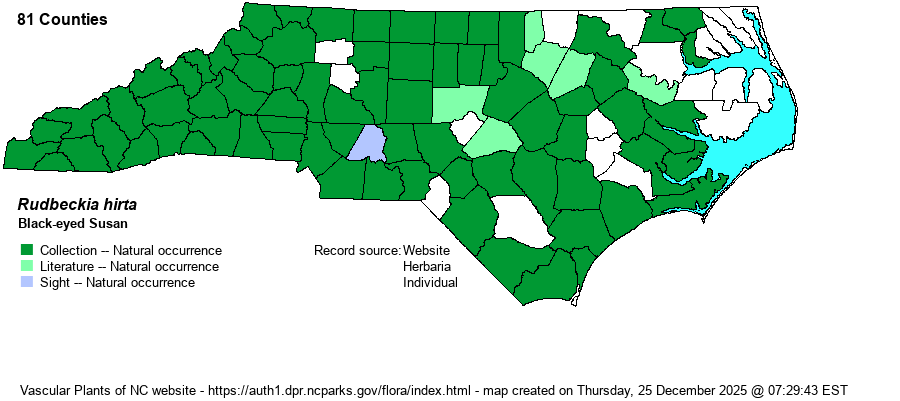| Author | L. | |
| Distribution | Nearly statewide, but scarce to absent in the northeastern counties.
Canada south to northern FL, southern TX, and NM.
| |
| Abundance | Common in the Mountains and the western Piedmont; fairly common at best in the rest of the state, except very rare or absent in the northeastern Coastal Plain. Scarce in the Sandhills region. | |
| Habitat | Dry to mesic soils of fields, wooded openings and margins, powerline clearings, roadsides, meadows, and other disturbed places. |
| Phenology | Blooms and fruits May-July. | |
| Identification | The familiar Black-eyed Susan grows 1-3 feet tall; it is rough-hairy on the stems and leaves. The leaves are very variable, but the basal and lower stem leaves have long petioles. The flowers are few on a plant, with bright golden-yellow rays and a dark brown to purple-brown and conical disk. The very rare Sun-facing Coneflower (R. heliopsidis) has smooth leaves and stem; the common Orange Coneflower (R. fulgida) has more orange-yellow rays and blooms from August to October, usually long after Black-eyed Susan is finished blooming. Though not overly common in the eastern and central parts of the state, it is a very familiar and widespread wildflower of the montane meadows and grassy fields. | |
| Taxonomic Comments | The species consists of several varieties in NC -- var. hirta, var. pulcherrima, and the apparently non-native var. angustifolia.
| |
| Other Common Name(s) | None | |
| State Rank | S5 | |
| Global Rank | G5 | |
| State Status | | |
| US Status | | |
| USACE-agcp | FACU link |
| USACE-emp | FACU link |

